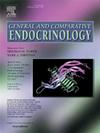环境温度与家雀对急性处理和约束应激生理反应日变化的关系
IF 1.7
3区 医学
Q3 ENDOCRINOLOGY & METABOLISM
引用次数: 0
摘要
气候变化正在改变环境极端事件的频率和强度,以及环境日变化速率。野生动物的日常反应规范表现出空间和时间的可塑性,使其能够对可预测的环境挑战做出适当的生理反应,但野生鸟类的这些反应很少被量化。我们通过确定生理应激指标(皮质酮[CORT]、葡萄糖[GLU]和循环热休克蛋白[Hsp])是否随环境温度(Ta)或一天中60个纬度梯度(320-380 S)的时间变化来解决这一问题。在2015年和2019-2020年,我们在三个不同的地点采集了家雀(Passer domesticus)的样本,以确定对捕获和处理压力的生理反应是否每天都在变化。正如预测的那样,应激期间血浆CORT和GLU升高。基线CORT和GLU水平在白天没有变化,但在最初基线CORT高的鸟类中,血浆CORT升高幅度(δ CORT)随着Ta的增加而下降,GLU的情况也是如此。基线和应激相关血浆CORT或GLU在不同采样地点均无一致性差异。热休克同源蛋白70 (Hsc70)和热休克蛋白90α (Hsp90)在白天表现出明显的时间动态。因此,热休克蛋白的反应规范在白天和每天的Ta变化中具有暂时的可塑性,CORT和GLU对急性应激的反应规范也是如此。然而,该研究提供了很少的证据表明,这种可塑性的反应规范,作为平均局部热条件的函数。本文章由计算机程序翻译,如有差异,请以英文原文为准。
Relationships between ambient temperature and diurnal variation in physiological responses to acute handling and restraint stress in the house sparrow, Passer domesticus
Climate change is altering the frequency and intensity of environmental extremes, and the diurnal rates of environmental change. The daily reaction norms of wild animals show spatial and temporal plasticity to allow appropriate physiological responses to predictable environmental challenges, but these responses have rarely been quantified in wild birds. We addressed this by determining whether physiological stress indices (corticosterone [CORT], glucose [GLU], and circulating heat shock proteins [Hsp]) vary with ambient temperature (Ta) or time of day across a 60 latitudinal gradient (320–380 S). We sampled house sparrows, Passer domesticus, at three locations with varying daily rates of Ta increases in 2015 and in 2019–2020 to determine whether physiological responses to capture and handling stress change diurnally. As predicted, plasma CORT and GLU increased during stress. Baseline CORT and GLU levels did not change during the day, but the amplitude of plasma CORT increase (delta CORT) in response to capture decreased as Ta increased, as was the case for GLU, in birds with initially high baseline CORT. Neither baseline nor stress-related plasma CORT or GLU differed consistently across sampling locations. Heat-shock cognate 70 (Hsc70) and heat-shock protein 90α (Hsp90) showed clear temporal dynamics across the day. Thus, the reaction norms of heat shock proteins are temporally plastic during the day and in response to daily Ta changes, as are the reaction norms of CORT and GLU in response to acute stress. However, the study provides little evidence for such plasticity in reaction norms as a function of average local thermal conditions.
求助全文
通过发布文献求助,成功后即可免费获取论文全文。
去求助
来源期刊

General and comparative endocrinology
医学-内分泌学与代谢
CiteScore
5.60
自引率
7.40%
发文量
120
审稿时长
2 months
期刊介绍:
General and Comparative Endocrinology publishes articles concerned with the many complexities of vertebrate and invertebrate endocrine systems at the sub-molecular, molecular, cellular and organismal levels of analysis.
 求助内容:
求助内容: 应助结果提醒方式:
应助结果提醒方式:


